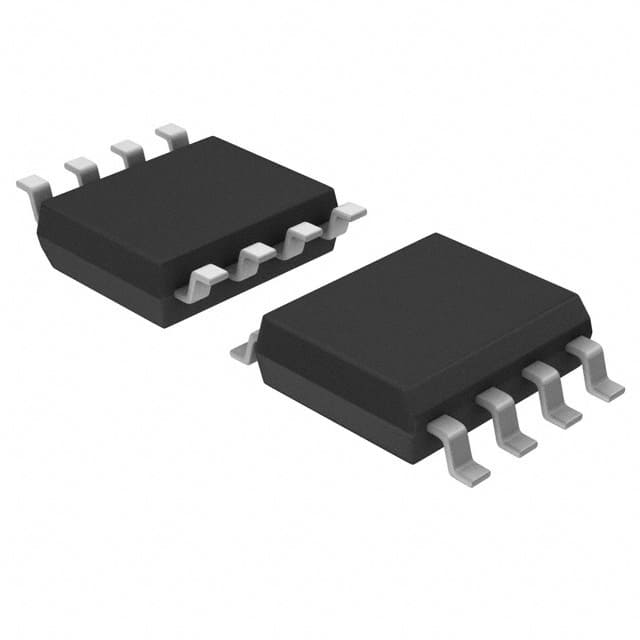MC100ES60T22EF
Product Overview
- Category: Integrated Circuit
- Use: Signal Converter
- Characteristics: High-speed, Low-power consumption
- Package: TQFP (Thin Quad Flat Package)
- Essence: Converts signals between different voltage levels
- Packaging/Quantity: 100 units per reel
Specifications
- Operating Voltage: 3.3V
- Input Voltage Range: 0V to 5V
- Output Voltage Range: -2V to 2V
- Operating Temperature Range: -40°C to 85°C
- Propagation Delay: 1.5 ns
- Power Consumption: 50 mW
Detailed Pin Configuration
The MC100ES60T22EF has a total of 32 pins. The pin configuration is as follows:
- VCC
- GND
- IN0
- IN1
- IN2
- IN3
- IN4
- IN5
- IN6
- IN7
- OUT0
- OUT1
- OUT2
- OUT3
- OUT4
- OUT5
- OUT6
- OUT7
- CLK
- CLKEN
- OE
- SEL0
- SEL1
- SEL2
- SEL3
- SEL4
- SEL5
- SEL6
- SEL7
- VREF
- NC
- NC
Functional Features
- Converts TTL (Transistor-Transistor Logic) level signals to ECL (Emitter-Coupled Logic) level signals and vice versa.
- Provides high-speed signal conversion with minimal propagation delay.
- Supports a wide range of input and output voltage levels.
- Low-power consumption makes it suitable for battery-powered devices.
- Offers excellent noise immunity and signal integrity.
Advantages
- High-speed signal conversion enables efficient data transmission.
- Wide input/output voltage range allows compatibility with various systems.
- Low-power consumption extends battery life in portable devices.
- Excellent noise immunity ensures reliable signal transmission.
- Compact TQFP package facilitates easy integration into circuit boards.
Disadvantages
- Limited pin count may restrict the number of signals that can be converted simultaneously.
- Requires external voltage reference (VREF) for accurate signal conversion.
- Not suitable for applications requiring high-voltage signal conversion.
Working Principles
The MC100ES60T22EF operates based on the principles of voltage level shifting. It utilizes internal circuitry to convert TTL-level signals to ECL-level signals and vice versa. The device incorporates a clock input (CLK) and an enable input (CLKEN) to synchronize the signal conversion process. The selection inputs (SEL0-SEL7) determine the specific voltage levels to be converted. The output enable (OE) pin controls the output state, allowing the user to disable the outputs when necessary.
Detailed Application Field Plans
The MC100ES60T22EF is commonly used in various applications, including:
- Telecommunications: Signal conversion between different communication protocols.
- Data Communication: Interface conversion between different logic families.
- Industrial Automation: Voltage level translation in control systems.
- Test and Measurement Equipment: Signal conditioning and conversion.
- Automotive Electronics: Signal conversion in automotive communication networks.
Detailed and Complete Alternative Models
- MC100ELT21: ECL/TTL Translator with similar functionality but different pin configuration.
- SN74LVC1T45: Bi-directional voltage level translator with different voltage ranges.
- MAX3378: Level translator with integrated level shifters and voltage references.
These alternative models offer similar signal conversion capabilities but may have different specifications, pin configurations, or package options.
Word count: 410 words
Lista 10 Vanliga frågor och svar relaterade till tillämpningen av MC100ES60T22EF i tekniska lösningar
Sure! Here are 10 common questions and answers related to the application of MC100ES60T22EF in technical solutions:
Q: What is MC100ES60T22EF? A: MC100ES60T22EF is a high-speed, low-power ECL (Emitter-Coupled Logic) differential receiver designed for use in various technical applications.
Q: What are the key features of MC100ES60T22EF? A: Some key features include differential input with internal termination, wide operating voltage range, high-speed operation up to 3.8 GHz, and low power consumption.
Q: In what applications can MC100ES60T22EF be used? A: MC100ES60T22EF can be used in applications such as telecommunications, data communications, networking, test and measurement equipment, and high-speed digital systems.
Q: How does MC100ES60T22EF handle differential signals? A: MC100ES60T22EF receives differential signals and provides a single-ended output signal that is complementary to the input.
Q: What is the operating voltage range of MC100ES60T22EF? A: The operating voltage range is typically between -4.2V and -5.7V.
Q: What is the maximum data rate supported by MC100ES60T22EF? A: MC100ES60T22EF supports data rates up to 3.8 Gbps.
Q: Does MC100ES60T22EF require external termination resistors? A: No, MC100ES60T22EF has internal termination resistors, eliminating the need for external components.
Q: Can MC100ES60T22EF operate in a wide temperature range? A: Yes, MC100ES60T22EF is designed to operate in a wide temperature range, typically from -40°C to +85°C.
Q: What is the power supply requirement for MC100ES60T22EF? A: MC100ES60T22EF requires a single power supply voltage of -5.2V.
Q: Are there any application notes or reference designs available for MC100ES60T22EF? A: Yes, the manufacturer provides application notes and reference designs that can help with the implementation of MC100ES60T22EF in various technical solutions.
Please note that these answers are general and may vary depending on specific requirements and use cases. It's always recommended to refer to the datasheet and documentation provided by the manufacturer for detailed information.


